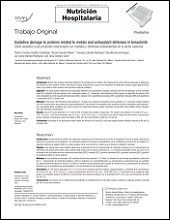Daño oxidativo a las proteínas relacionado con metales y defensas antioxidantes en la leche materna
Oxidative damage to proteins related to metals and antioxidant defenses in breastmilk
| dc.creator | PATRICIA CAROLINA CASTILLO CASTAÑEDA | |
| dc.creator | RAMON GAXIOLA ROBLES | |
| dc.creator | VANESSA LABRADA MARTAGON | |
| dc.creator | BAUDILIO ACOSTA VARGAS | |
| dc.creator | LIA CELINA MENDEZ RODRIGUEZ | |
| dc.creator | TANIA ZENTENO SAVIN | |
| dc.date | 2017 | |
| dc.identifier | http://cibnor.repositorioinstitucional.mx/jspui/handle/1001/884 | |
| dc.identifier.uri | http://dspace.cibnor.mx:8080/handle/123456789/1867 | |
| dc.description | "Introducción: la leche materna contiene las moléculas necesarias para el desarrollo de los niños; la integridad y función de estas moléculas se afecta por la presencia de prooxidantes. Los carbonilos proteicos se producen principalmente como resultado de la interacción de metales con especies reactivas de oxígeno (ERO), los cuales pueden iniciar una reacción en cadena que promueve la oxidación molecular. Objetivo: este estudio tiene como objetivo determinar la asociación entre la concentración de carbonilos proteicos con la concentración de elementos traza (plomo [Pb], cadmio [Cd] y selenio [Se]), producción de radical superóxido (O2 •-), y contenido de glutatión (GSH), así como con la actividad de las principales enzimas (superóxido dismutasa [SOD], catalasa [CAT], glutatión peroxidasa [GPx], glutatión reductasa [GR] y glutatión S-transferasa [GST]) en leche materna. Métodos: en este estudio se analizaron 108 muestras de leche de transición (7-10 días). La actividad de las enzimas antioxidantes, producción de O2 •-, concentración de carbonilos proteicos y GSH se analizaron por espectrofotometría. La concentración de elementos traza se cuantifi có por espectrometría de absorción atómica. Se utilizó un modelo lineal generalizado para evaluar la relación entre la concentración de carbonilos proteicos con los indicadores de estrés oxidativo y las concentraciones de elementos traza. Resultados: Cd y Pb fueron detectados en 21,3 y 55,6% de las muestras de leche materna, respectivamente. La mediana de la concentración de Cd fue 0,01 µg l-1 (0,01-3,52 µg l-1) y para la concentración de Pb fue 2,61 µg l-1 (0,08-195,20 µg l-1). De acuerdo con el modelo de mejor ajuste, los principales factores de afectan la concentración de carbonilos proteicos, son la actividad de GPx y GR, y las concentraciones de GSH, Se, Pb y Cd. Conclusiones: de acuerdo con el modelo lineal generalizado, la actividad de GPx y GR podría ayudar a explicar la oxidación proteica, inducida por Pb y Cd en leche materna." | |
| dc.description | "Introduction: Breast milk contains molecules needed for the development of children; the integrity and function of these molecules is affected by the presence of pro-oxidants. Protein carbonyls are mainly produced as a result of the interaction of metals with reactive oxygen species (ROS), which may initiate a chain reaction that promotes molecular oxidation. Objective: This study aimed to determine the association between the concentration of protein carbonyls with the concentration of trace elements (lead [Pb], cadmium [Cd] and selenium [Se]), superoxide radical (O2 •-) production, and glutathione (GSH) content, as well with the activity of the main antioxidant enzymes (superoxide dismutase [SOD], catalase [CAT], glutathione peroxidase [GPx], glutathione reductase [GR] and glutathione S-transferase [GST]) in breast milk. Methods: In this study 108 transitional milk samples (7-10 days) were analyzed. Antioxidant enzyme activities, O2 •- production, protein carbonyl and GSH concentrations were analyzed by spectrophotometry. Trace element concentration was quantifi ed by atomic absorption spectrophotometry. Generalized linear modelling was used to assess the relationship between protein carbonyls concentration with oxidative stress indicators and trace elements concentration. Results: Cd and Pb were detected in 21.3 and 55.6% of breast milk samples, respectively. The median concentration of Cd was 0.01 µg L-1 (0.01-3.52 µg L-1) and Pb concentration was 2.61 µg L-1 (0.08-195.20 µg L-1). According to the best-fi t model, the main factors contributing to protein carbonyl concentrations were the activity of GPx, GR, and concentration of GSH, Se, Pb and Cd. Conclusions: According to the generalized linear model, the activity of GPx and GR, could help explain protein oxidation induced by Pb and Cd in breast milk." | |
| dc.format | application/pdf | |
| dc.language | eng | |
| dc.publisher | Sociedad Española de Nutrición Parenteral y Enteral | |
| dc.relation | info:eu-repo/semantics/datasetURL/URL: http://revista.nutricionhospitalaria.net/index.php/nh/index | |
| dc.relation | info:eu-repo/semantics/reference/ISSN/ISSN: 0212-1611 | |
| dc.relation | citation:Castillo-Castañeda PC, Gaxiola-Robles R, Labrada-Martagón V, Acosta Vargas B, Méndez-Rodríguez LC, Zenteno-Savín T. Oxidative damage to proteins related to metals and antioxidant defenses in breastmilk. Nutr Hosp 2017;34:59-64 | |
| dc.rights | info:eu-repo/semantics/openAccess | |
| dc.rights | http://creativecommons.org/licenses/by-nc-nd/4.0 | |
| dc.source | Nutrición hospitalaria | |
| dc.subject | info:eu-repo/classification/AUTOR/Antioxidantes, Leche materna, Carbonilos proteicos, Elementos traza. | |
| dc.subject | info:eu-repo/classification/AUTOR/Antioxidants, Breast milk, Protein carbonyls, Trace elements. | |
| dc.subject | info:eu-repo/classification/cti/2 | |
| dc.subject | info:eu-repo/classification/cti/24 | |
| dc.subject | info:eu-repo/classification/cti/2411 | |
| dc.subject | info:eu-repo/classification/cti/241010 | |
| dc.subject | info:eu-repo/classification/cti/241010 | |
| dc.title | Daño oxidativo a las proteínas relacionado con metales y defensas antioxidantes en la leche materna | |
| dc.title | Oxidative damage to proteins related to metals and antioxidant defenses in breastmilk | |
| dc.type | info:eu-repo/semantics/article | |
| dc.type | info:eu-repo/semantics/publishedVersion |


